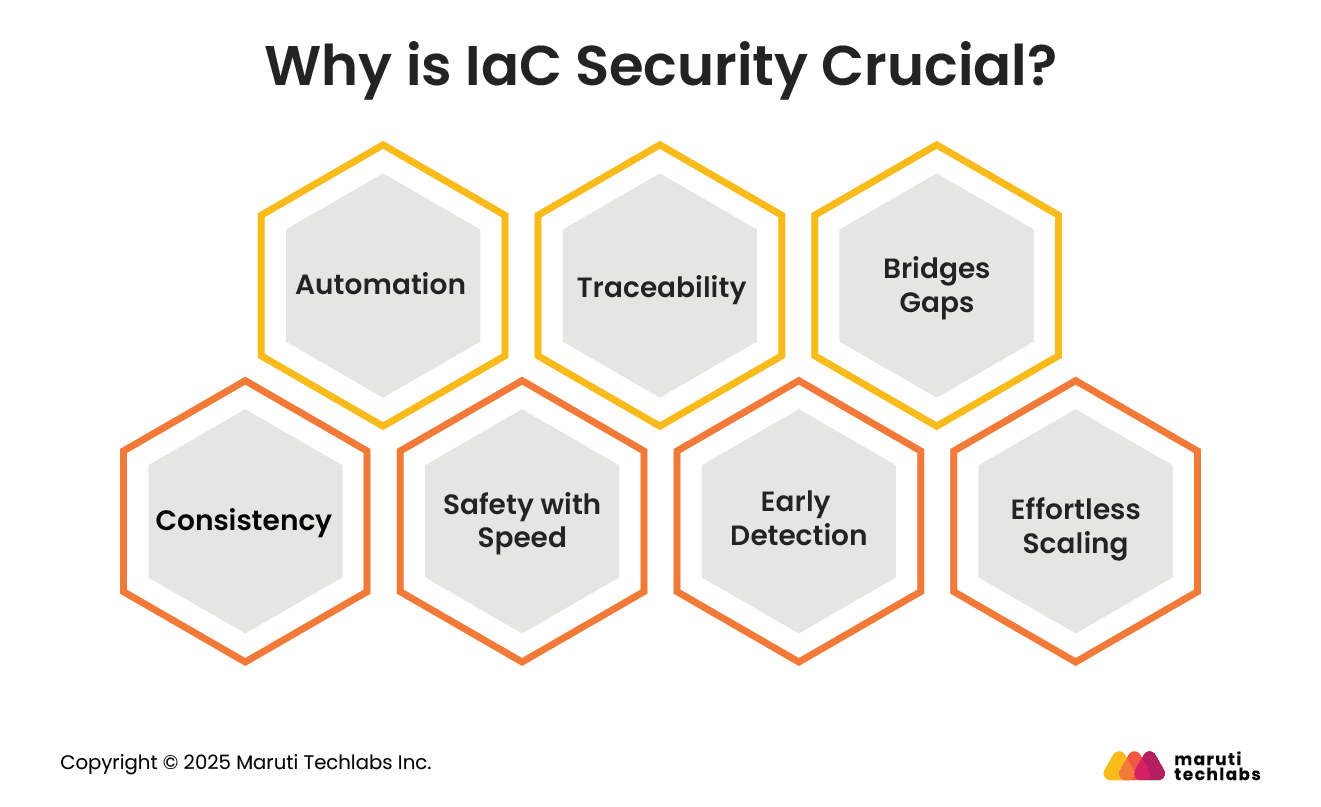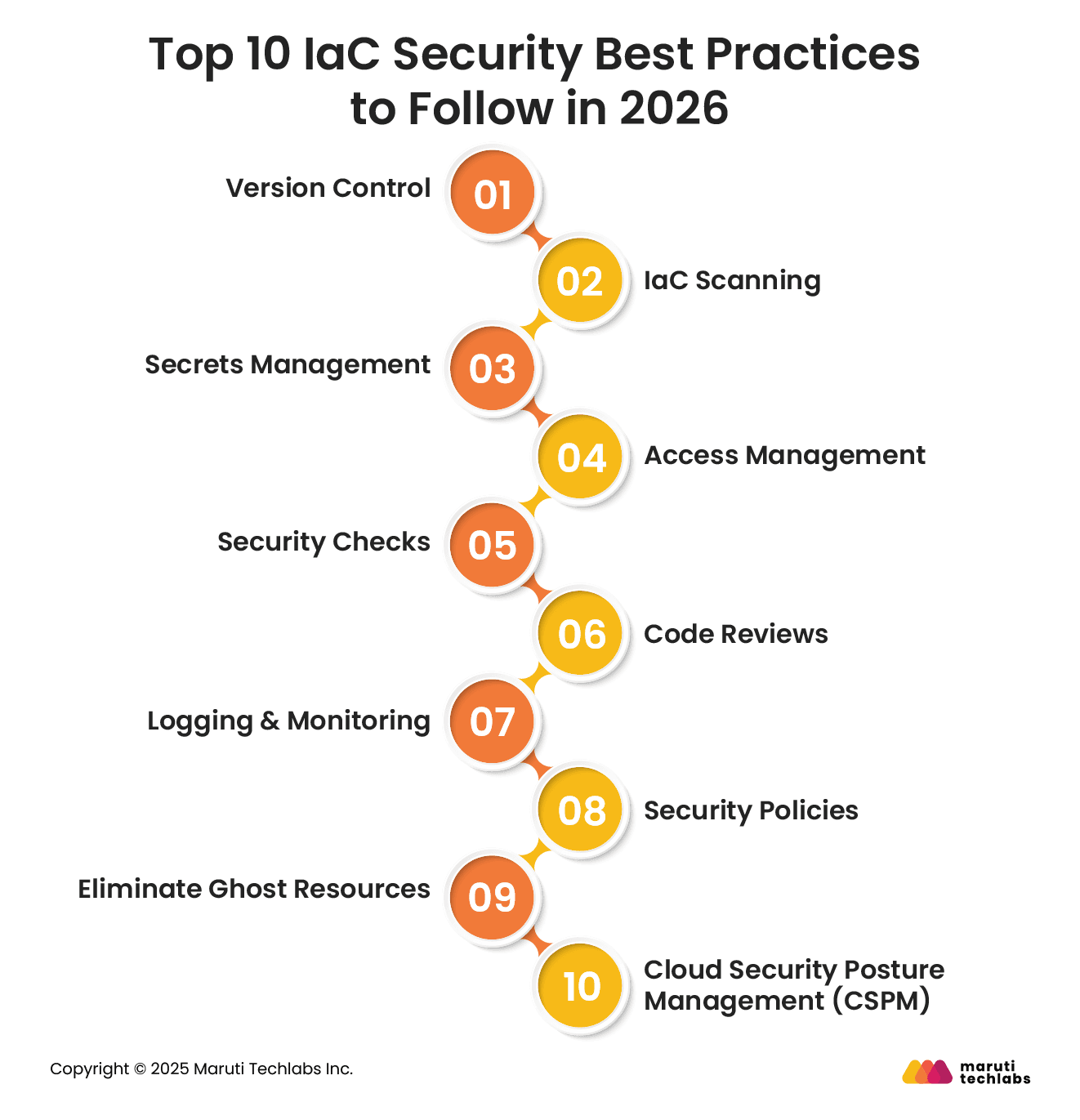

IaC Security: Prevent Hidden Risks Before They Break Your Cloud






Infrastructure as Code (IaC) is the practice of defining and managing infrastructure through machine-readable configuration files, rather than manual setups, a method that turns provisioning into a code-based process.
Teams use IaC to automate the provisioning of cloud resources like VMs, containers, and networks, enabling repeatable, scalable, and consistent environments. Security teams embrace IaC because it allows them to introduce security controls early, enforce policy-as-code, and catch vulnerabilities before they reach production.
But when IaC is misconfigured through hard-coded secrets, weak IAM policies, or unencrypted storage, it can lead to exposure and security risks.
In this blog, we’ll cover the main risks, recommended best practices, and the role of IaC security in building secure cloud environments.
Infrastructure as Code Security is the practice of inculcating code-based automation to set up and manage IT infrastructure. It ensures that the configurations are consistent and easily reproducible.
IaC security helps organizations standardize and automate infrastructure configuration consistently. However, if companies fail to follow proper practices, they may face security risks, including compliance issues, misconfigurations, and cyber breaches.
To prevent vulnerabilities in cloud environments, it is crucial to follow IaC security best practices. IaC security approach offers more than automating deployments; it enhances visibility, prevents unauthorized changes, and applies all-around security. In addition, it eliminates security gaps and maintains security throughout the setup.
Here are the essential benefits IaC security offers, making it critical for securing your cloud environments.

IaC security ensures consistency in your security standards across all your cloud resources. It mitigates all protection gaps that may lead to accidental human errors.
Manual configurations often introduce errors during deployment. Leveraging IaC templates to apply security controls offers a holistic approach to shield your infrastructure without any hassle.
When security is built into IaC templates, additional checks during deployment are no longer required. The result is faster rollouts with consistent security enforcement.
Your audit configurations, changes, and rollback security are readily available to review using version-controlled templates. This approach improves accountability and makes tracking configuration changes easier.
By integrating security checks in the development pipeline, one can save ample time, money, and resources. This eliminates the need to wait until the last moment to address critical issues.
IaC security enhances collaboration between security and DevOps teams by providing tools to resolve issues in their workflows.
IaC security helps you scale effortlessly while maintaining your security. It meets your demand for fast growth while adequately safeguarding your cloud environments.
Although automation offers numerous benefits, it also entails specific challenges and risks. Let’s learn what they are.
A single IaC template misconfiguration can lead to multiple security and operational issues. For instance, an AWS CloudFormation template sets a security group to the public, sharing confidential information.
Then there are manual or undocumented changes, which constitute configuration drift and can affect the system over time.
These are resources that have been forgotten or are untagged. For instance, a marketing company is using Azure Resource Manager without tagging its storage resources.
In no time, these resources can become numerous, and if left unattended, they can not only incur additional costs but also widen the attack surface. This demonstrates why resource tagging is necessary for management and security.

A privilege escalation attack can occur if secrets are stored in plain text or in an insecure manner.
An e-commerce platform using Ansible stores API secrets in plain text, which an audit may expose, risking privilege escalation if those credentials are leaked.
Your attack surface expands if users have unnecessary access to services they don’t require. Follow the Principle of Least Privilege (PoLP) by granting only the permissions that are needed.
The following best practices have been proven and selected to protect your cloud environments from unwanted surprises.
Version control helps track changes to IaC templates and allows safe rollback when issues occur. Whether it’s a small change or an overhaul, storing IaC templates in platforms like Git makes every change traceable.
This provides access to previous versions in case something goes wrong during or after introducing a new update. Additionally, it offers a complete audit trail, stating when a change was made and by whom.
Security gaps shouldn’t go unaddressed. Timely IaC scans can help you identify compliance missteps, incorrectly coded credentials, and misconfigurations before they escalate into larger issues.
You don’t need to store hard-coded, confidential data, such as passwords and APIs. One can leverage secret management tools, such as AWS Secrets Manager. They offer increased security for your secrets, eliminating the risk of them being compromised within your codebase.
The metaphor ‘less is more’ is significantly useful when it comes to permissions. It means offering only the access that is absolutely needed. PoLP helps contain security breaches and shield other accounts if one of them is compromised.
Organizations wait until deployment to discover security vulnerabilities. However, the best practice is to introduce automated security checks in your CI/CD pipelines to detect security issues before they are deployed into production.
Automated checks ensure insecure configurations are flagged before deployment.

When discovering security blind spots, more overhead can only benefit. Vulnerabilities, such as misconfigurations that have slipped through automated scans, can be unearthed with timely peer reviews.
Additionally, this is an ideal way to enhance and share security knowledge while enforcing stringent security practices within your teams.
You can’t secure what you can’t see. Therefore, it’s crucial to keep an eye on your deployed resources. Logs are your primary line of defense. Whether it’s spotting anomalies, changes, or responding to incidents, logs are the most reliable source for conducting audits and investigations.
Address your compliance requirements by enforcing clear security and best practices. Ensure consistent application across your ecosystem using policy-as-code tools such as Sentinel.
Vulnerabilities can make their way through inactive resources such as unlinked storage buckets or abandoned VMs. Reduce attack surface and enhance cloud health by eliminating unused resources and performing timely audits.
Cloud Security Posture Management (CSPM) is no small feat, but leveraging tools that offer assistance can make it easier. These tools help you address smaller issues before they escalate by monitoring your deployments 24/7, promptly flagging violations and other issues.
Infrastructure drift is often invisible until it causes real issues, such as failed deployments, inconsistent environments, security vulnerabilities, or compliance gaps.
Recognizing and preventing drift is vital for maintaining reliable Infrastructure as Code and ensuring predictable deployments.
By implementing version control, security checks, and access management, organizations can significantly reduce risk while enhancing deployment speed and consistency across environments.
If your team needs support improving IaC maturity, Maruti Techlab’s Technology Advisory Services can assist with assessments, best-practice frameworks, and actionable recommendations.
Partner with us to identify gaps, strengthen your IaC strategy, and ensure your infrastructure remains aligned, secure, and resilient.
And if you're planning broader modernization or cloud restructuring, our Cloud Migration Cost Calculator can help you estimate migration expenses and plan your roadmap with confidence.
IaC prevents configuration drift by ensuring all infrastructure changes are made through version-controlled code rather than manual updates.
This creates a single source of truth, enforces consistent deployments, and allows automated tools to detect and correct deviations, keeping environments aligned across development, staging, and production.


